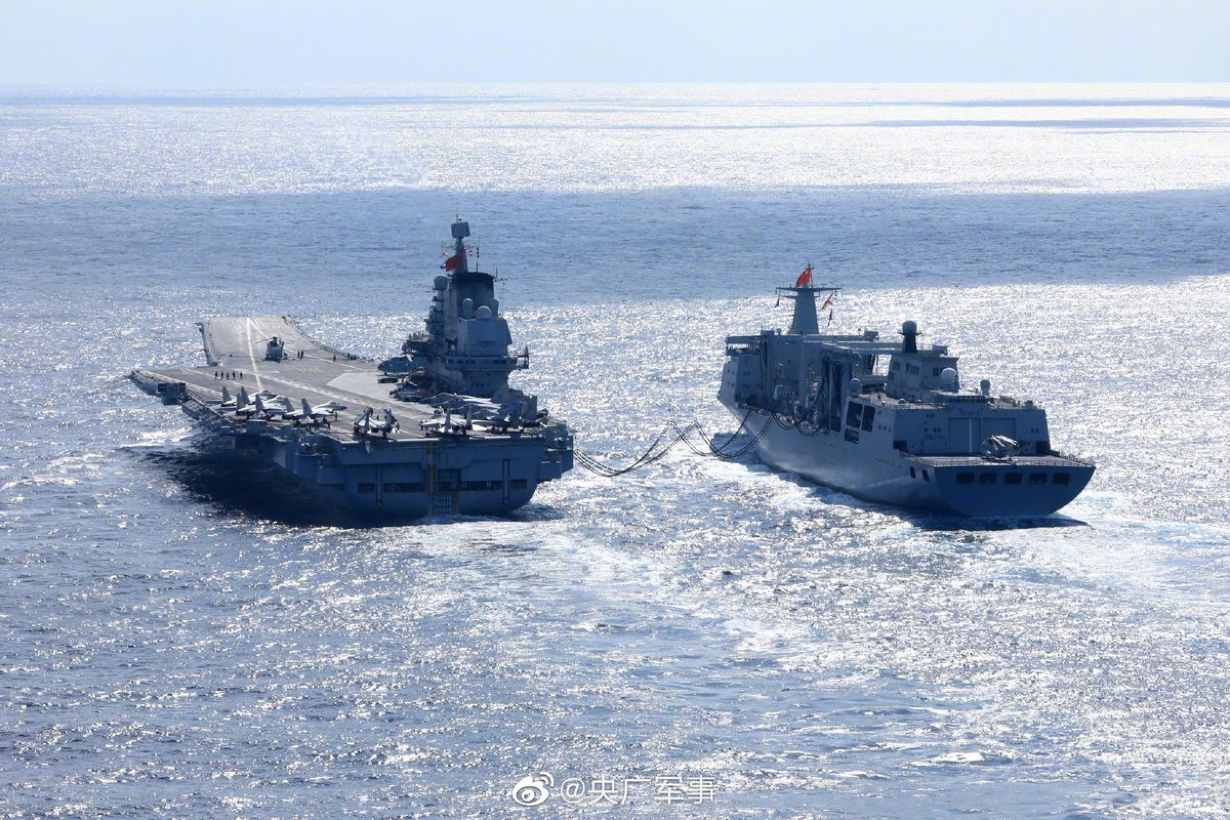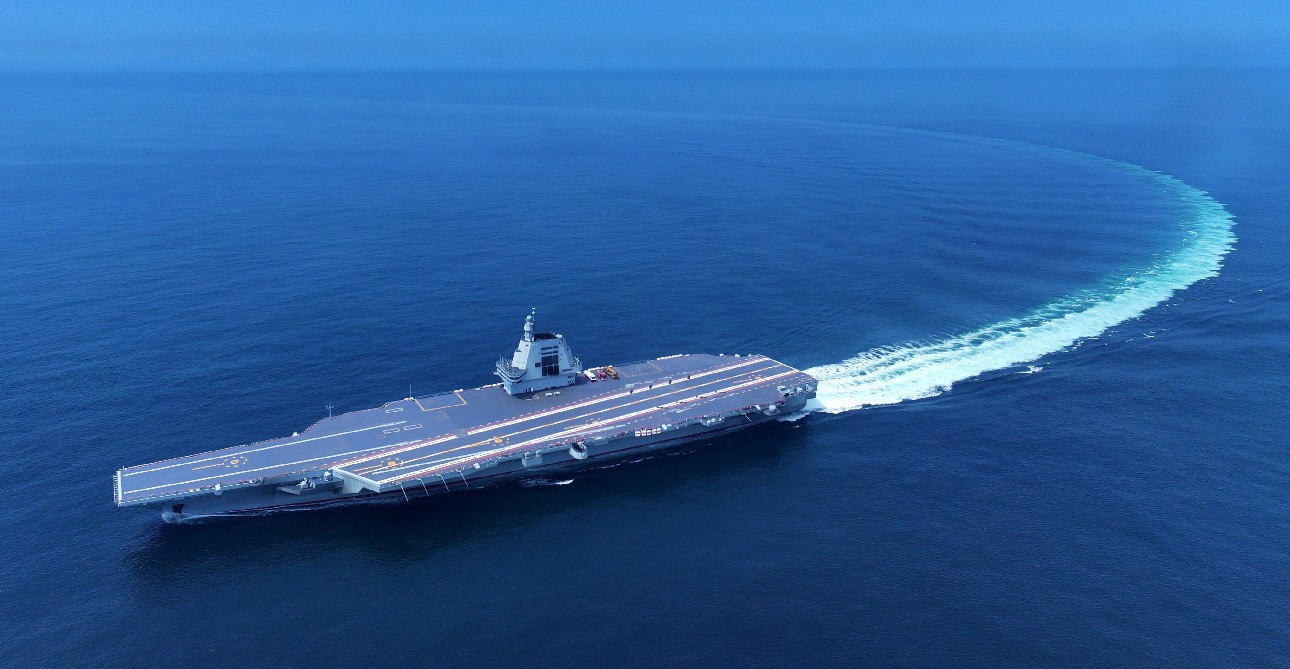China Flaunts “Ukrainian Warship” To Project Power Near Japan. Sails Into It’s Contiguous Zone For The 1st Time

A Chinese carrier battle group led by a ‘Ukrainian-origin’ Aircraft Carrier entered Japan’s contiguous zone for the first time. This development indicates China’s growing confidence in projecting power beyond its borders to support its national interests and foreign policy.
The US Navy has the world’s largest aircraft carrier fleet, with 11 in service. China ranks second with three ships launched.
As the world is still debating whether submarines are better investments than aircraft carriers, China’s third and most advanced “super-carrier,” Fujian, has started testing its electromagnetic catapult system. This makes it the second navy besides the US Navy to have the technology. This suggests the warship remains on course for its planned deployment in 2025.
Going for conventional propulsion suggests that, as of now, the Chinese Navy has a regional focus. It wants to secure its strategic interests in the Western Pacific and South China Sea first by prioritizing shipbuilding.
AfriPrime App link: FREE to download...
https://www.amazon.com/Africircle-AfriPrime/dp/B0D2M3F2JT
The expansion of the Chinese Navy is also in the offing. By 2035, the Navy will be able to field six carriers. The fourth Type 004 carrier, reportedly under construction, is rumored to have nuclear propulsion that will catapult the country into a true blue global navy. It will increase Beijing’s reach to distant waters like the Indian Ocean and beyond.
China has already started testing the waters. On September 18, the Chinese carrier Liaoning, accompanied by two destroyers, sailed between Japan’s westernmost island of Yonaguni and nearby Iriomote, entering the country’s “contiguous zone”.
The Contiguous Zone is an area of sea beyond a country’s territorial waters in which it can still exercise some control over maritime traffic, reaching up to 24 nautical miles offshore.
The Liaoning’s transit was part of a fleet movement Tuesday and Wednesday when Chinese warships also passed off the western coast of the disputed Japanese-controlled islets called the Senkakus by Tokyo. China claims the same islets, calling them the Diaoyus.
The Chinese aircraft carrier’s flexing of muscles shows that China has come a long way since it converted the rag-tag warship it acquired from Russia into a functional aircraft carrier.
China’s First Aircraft Carrier – Varyag
Chinese Navy chief Admiral Liu Huaqing planned that the People’s Liberation Army Navy needed to transform from a coastal defense force to one capable of projecting power into the Western Pacific. He contended that transformation could not happen without an aircraft carrier.
The keel for Varyag was laid in 1985 in Ukraine. It was launched in 1988 but it lacked critical components like an electrical system. The Kuznetsov-class carrier was intended to be the pearl of the Soviet naval fleet, but following the USSR’s collapse, the Ukrainian government needed to sell it to help dig it out of dire financial straits.
AfriPrime App link: FREE to download...
https://www.amazon.com/Africircle-AfriPrime/dp/B0D2M3F2JT
As the years passed, Varyag was stripped of other parts as well, leaving it in a decrepit condition by 1998. Also, the high cost of the refit seemed like an idea China would not pursue.
The refit of the smaller Kiev-class aircraft carrier Admiral Gorshkov, rechristened INS Vikramaditya for the Indian Navy, has cost over $2.3 billion. Early estimates for the refit of the Varyag placed the cost at roughly $2 billion.
It was then China came up with a well-thought-out plan to lay its hand on the warship that would save it 10 years of research and development.
China, with the help of businessman and former basketball player Xu Zenping, executed the purchase on behalf of the Chinese government. Xu convinced the Ukrainians that Varyag would be turned into a floating casino in Macau.
He borrowed US $30 million to set up a fake company and began negotiations with the shipyard. He then finalized the deal to buy Varyag from Ukraine for a mere US $20 million. The Chinese subterfuge worked, as no one thought the warship could become seaworthy.
After this began the odyssey to bring Varyag to China. Varyag was towed by a Dutch vessel. However, Turkey refused its passage through the Bosphorus River for over 500 days. As the towing costs mounted, the Chinese government intervened to facilitate passage for the warship. After a series of mishaps, like a tropical storm and broken cable, Varyag arrived in China in 2002.

Despite the world’s misgivings about Varyag’s actual use, China kept on working on the aircraft carrier in silence. It was only in 2011 that, in an interview with the Hong Kong Commercial Daily, the chief of the PLA’s General Staff, Chen Bingde, confirmed that China’s first carrier was under construction.
After extensive modernization and refitting, the Varyag was transformed into the Liaoning in 2012.
Initially, China had stated that Varyag would be utilized for “scientific research, experiment, and training,” but China became the 10th country in the world to own an aircraft carrier and the last permanent member of the UN Security Council to have one.
Contrary to this, the Indian Navy acquired its first aircraft carrier, INS Vikrant, in 1957 and commissioned it in 1961. INS Vikrant was the first aircraft carrier owned by an Asian country and remained so for a long time.
From Varyag to Fujian
However, after Varyag, China lost no time. With its second carrier built indigenously, it is a key piece in the PLA Navy’s pursuit to challenge the US Navy’s dominance. Fujian aspires to rival its US counterparts in terms of size and technology with its electromagnetic catapults.
If the United States intervenes in a conflict over Taiwan, Fujian is expected to play a key role in “the PLA’s anti-access and area denial strategy.” Fujian derives its name from the eastern coastal province facing the island of Taiwan.
The electromagnetic catapult will enable it to launch heavier and larger fixed-wing aircraft with greater fuel and weapons loads. The US Navy’s latest Gerald R. Ford-class carriers feature an electromagnetic catapult launch system.
The electromagnetic catapult also enables faster take-offs, increases energy efficiency, and reduces stress on aircraft frames during take-offs.
It enables the deployment of a wider variety of aircraft, encompassing both piloted and potentially unmanned options. This includes the capacity to launch transport aircraft and fixed-wing airborne early-warning and control aircraft, significantly enhancing the carrier’s operational versatility.
The Fujian is much bigger than the previous Chinese aircraft carriers. As against the Liaoning’s 60,000 tonnes and the Shandong’s 66,000, the Fujian displaces roughly 80,000 tonnes.

It is much bigger than France’s aircraft carrier Charles de Gaulle (42,000 tonnes) and the United Kingdom’s HMS Queen Elizabeth (65,000 tonnes), but it is smaller than the US Navy’s Ford-class carrier, which has a displacement of 100,000 tonnes.
The only technological disadvantage it has in comparison to the US and French carriers is that they are not nuclear-powered.
China’s first carrier, Liaoning (Varyag), is based in Qingdao, East China’s Shandong Province, near the East China Sea, Yellow Sea, and Bohai Sea. The second carrier, Shandong, is based in Sanya, South China’s Hainan Province, near the South China Sea. The homeport of Fujian is yet not known.

China needs at least three aircraft carriers to maintain air superiority and control of the sea in the strategic Indo-Pacific region. The testing of Fujian also demonstrates China’s ability to construct warships domestically at a feverish pace.
An aircraft carrier is a mini floating ‘airbase’ at sea which sets it apart from other warships in terms of operations, reach, and complexities.
The freedom of navigation and overflight in international waters, the right of innocent passage of territorial waters, and the right of transit passage of international straits guaranteed by the United Nations Convention on Law of the Sea (UNCLOS) provide an aircraft carrier with worldwide mobility.
It can reach any conflict area, as most of the earth is accessible by sea and remains there for extended periods.
Despite the advantages, it is also true that there have been no aircraft carrier battles after World War II. Most carriers after the World Wars have retired without ever participating in a battle. Many countries are reassessing the strategic utility of these sea leviathans, especially as countries are investing in sea-denial platforms like submarines and unmanned underwater vehicles.
AfriPrime App link: FREE to download...
- Questions and Answers
- Opinion
- Story/Motivational/Inspiring
- Technology
- Art
- Causes
- Crafts
- Dance
- Drinks
- Film/Movie
- Fitness
- Food
- Games
- Gardening
- Health
- Home
- Literature
- Music
- Networking
- Other
- Party
- Religion
- Shopping
- Sports
- Theater
- Wellness
- News
- Culture
- War machines and policy

